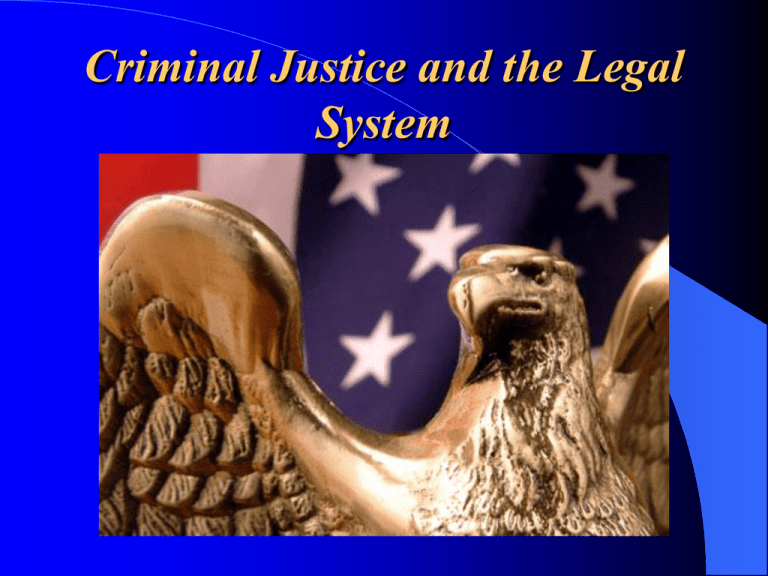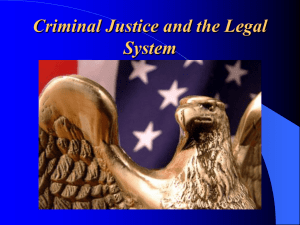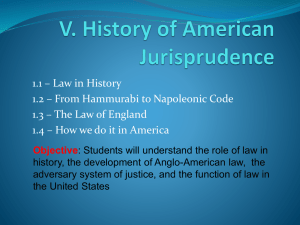File
advertisement

Criminal Justice and the Legal System “Legal Rights & Responsibilities” Sources of Law Where do we get our laws from? – “Statutory” Law – laws from statutes – “Case” Law – based on Supreme Court decisions – “Common” Law – based on tradition – The US Constitution also gives us law. “Statutory” Law Any law that is passed by a legislative body is called a statute, or statutory law. Congress, state legislatures and local government all pass these kinds of laws. They can be criminal or civil and usually reflect what majority of people would consider to be right or wrong. Example: The law that says all buildings have to have fire exits is a statute. “Case” Law A source of law based on the decisions and outcomes of cases heard by the Supreme Court Landmark Supreme Court Case: Gideon v. Wainwright (1963) “Common” Law Common Law is law that is based on precedent (ruling on earlier cases) and customs (tradition). Example: having a jury trial in front of a judge is a part of common law. Types of Laws There are several different types of law that affect Americans directly today that help maintain a peaceful and orderly society – “Military” Law – “Constitutional” Law – “Criminal” Law – “Civil” Law – “Juvenile” Law “Military” Law Military Law governs the behavior of the men and women that serve in the US Armed Forces. This law is supported by the Uniform Code of Military Justice and addresses laws related to desertion, treason, crimes of war, treatment of prisoners, and the military trial process. “Constitutional” Law Based on the Constitution Is the basis for much of what becomes “case” law “Criminal” Law “Criminal” laws are laws that seek to prevent people from deliberately or recklessly harming a person or someone’s property. Our Court System American courts operate on an adversary system of justice, meaning the courtroom serves as an “arena” in which lawyers for opposing sides try to present their strongest case. “Criminal” Cases In these types of cases, the government always acts as the “plaintiff” (the person bringing the charges) and the person being charged/sued is the “defendant”. “Criminal” Law Two types of Crimes: – “Felonies” – “Misdemeanors” Felonies Crimes “Felony” crimes are the most serious crimes with the most serious consequences (murder, rape, kidnapping, robbery, etc.) Misdemeanor Crimes “Misdemeanor” crimes are less serious and often do not have very serious consequences (vandalism, theft, traffic violations, etc.) Criminal Process Once an arrest has been made by law enforcement, the suspect will be informed of his/her rights. – Video Criminal Process Suspects then appear before the court in a “hearing” to hear the charges against them and listen to the judge’s decision on the next step. Criminal Process At an “arraignment”, suspects formally hear the charges and are asked to enter a “plea”. They will enter “guilty”, “not guilty”, or “no contest (“I do not wish to contend = “nolo contendre”) – does not dispute the charge… Criminal Process During a criminal trial, there are four steps: 1. Opening Statements 2. Testimony of Witnesses 3. Closing Statements 4. Verdict (Outcome) Step #1: Opening Statements The first step of a criminal trial is allowing both the prosecution (State) and the defense (the accused) make an opening statement to the judge and jury. This is where the jury gets the “basics” about the case and learns about the facts they need to listen for. Step #2: Testimony of Witnesses The Prosecution and Defense will call witnesses to give their testimony (or give answers under oath) in the case. These witnesses will also be “cross examined” by the other side. Step #3: Closing Statements Near the end of the trial, the prosecution and the defense give their closing statements which summarize the arguments made, the testimony given and is the final opportunity for the attorneys to request a favorable outcome from the jury. Step #4: Verdict After the closing statements have been given, the jury will leave to deliberate, or discuss and review the evidence and facts that was presented. Once their reach a unanimous decision, the jury will return to court and read their verdict (official outcome) to court. Criminal Process Defendants are either found “guilty”, are “acquitted” (found “not guilty”), or the judge can declare a “hung jury” (a “mistrial” is declared by the judge) Criminal Penalties Criminal penalties are designed to: – Provide punishment so the criminal pays for the crime against a victim or society – Remove prisoners so they are not a threat to society – Deter criminals from committing repeated crimes – “Rehabilitate” criminals so they can reenter society and become productive members “Civil” Law “Civil” laws are for disputes between people or groups of people in which no criminal laws have been broken. Since there is no threat to society, the state does not take action. In other words, civil disputes are disagreements over non-criminal matters. “Civil” Law When a civil case goes to court, it is called a “lawsuit”, which is a legal action in which a person or group sues to collect “damages” (an award of money) for some harm that is done. “Civil” Law A case begins when a “complaint” is filed (a formal statement naming those involved and describing the nature of the lawsuit) Once filed, a “summons” (a document notifying the defendant of the lawsuit against them and an order a to appear) is sent by the court. “Civil” Law A defendant may respond to the suit in a “pleading” (complaint and answer together). “Discovery” is the name of the process in which lawyers for the plaintiff and defendant check facts and gather evidence for the case “Civil” Law In an “equity” lawsuit, issues are resolved by a judge based on the grounds of fairness. Judges often issue an “injunction” (or a court order commanding a person or group to stop a certain action) Legal Protections in the U.S. Constitution Rulings in court cases are decided by written laws and precedents of earlier cases. Legal Protections in the U.S. Constitution Citizens are protected from the suspension of their “Writ of habeas corpus” is a court order that requires police to bring a prisoner to court to explain why they are holding the person Legal Protections in the U.S. Constitution Citizens are protected from “Bills of attainder” are laws that punish a person accused of a crime without a trial or a fair hearing in court. Legal Protections in the U.S. Constitution Citizens are protected from “Ex post facto laws” are laws that allow a person to be punished for an action that was not against the law when it was committed. Legal Protections in the U.S. Constitution “Due process” is the legal procedures established when dealing with the accused. Amendment Protection Several of the amendments of the Constitution help protect the rights of the “accused”: – Fourth – Fifth – Sixth – Eighth “Fourth Amendment” This amendment protects the rights of the accused with no“unreasonable searches and seizures” Law enforcement must obtain a “search warrant” “Fifth Amendment” This amendment protects the rights of the accused: – – – – Right of due process No “double jeopardy” No self incrimination Right to a “grand jury” “Sixth Amendment” This amendment protects the rights of the accused by granting legal counsel (or a lawyer) If the accused can not afford one, the state must provide one. “Eighth Amendment” This amendment protects the rights of the accused by forbidding “cruel and unusual punishments” or “excessive bail” – “Bail” – video Young People & the Courts video Citizens under a certain age are considered “juveniles” (18 in most states) Those who commit crimes against society are considered to be “juvenile delinquents” (not old enough for adult courts) Laws that are applied juveniles are called juvenile law. Young People & the Courts Most crimes committed by juveniles are “misdemeanors” (less serious) However, juveniles do commit “felonies” (more serious). Young People & the Courts The primary goal of the juvenile court is to “rehabilitate” the juvenile (or correct the behavior) rather than to punish. These courts basically handle “neglect” and “delinquency” cases Young People & the Courts Many police departments have officers who try and “divert” these juveniles. Young People & the Courts While court trials for juveniles are similar to adults, they do NOT have the right to a jury trial. The judge makes the decision. Young People & the Courts The rights of juveniles were established in the 1967 “In re Gault” Supreme Court case – video Young People & the Courts Unlike adult trials, the identity of juveniles is kept secret and the criminal records of these juveniles can be erased (expunged) when they reach adulthood.











